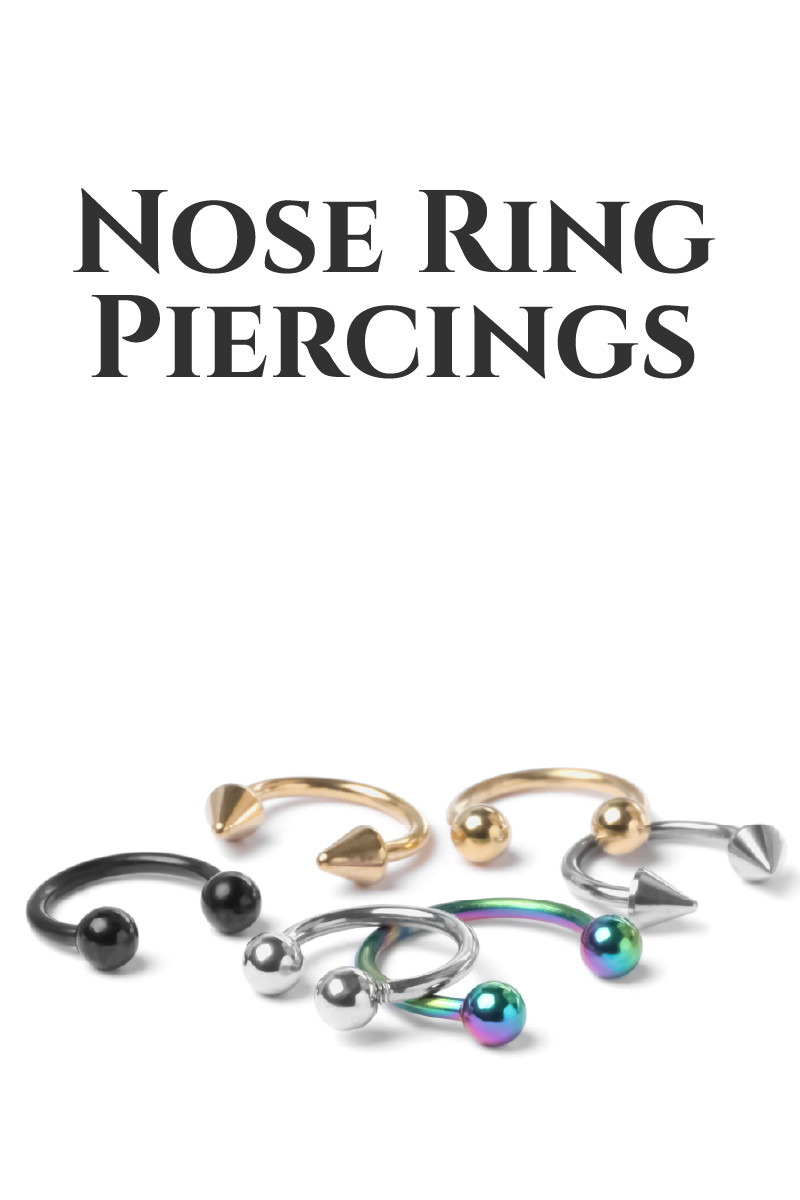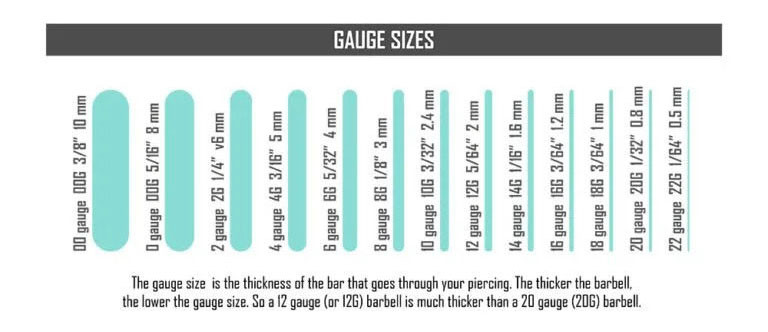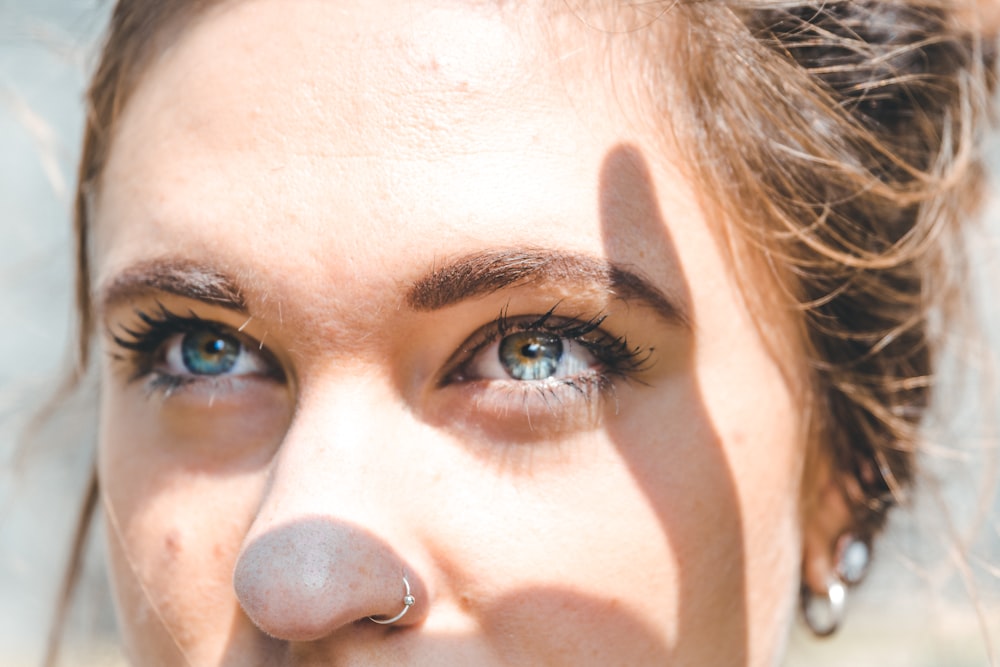
Piercing au nez 101 : types, styles et soins ultérieurs
 Aujourd’hui, les piercings au nez peuvent avoir une signification culturelle et exprimer votre individualité.
Aujourd’hui, les piercings au nez peuvent avoir une signification culturelle et exprimer votre individualité.
Cependant, les piercings au nez remontent à des milliers d'années et sont très répandus dans les cultures orientales.
Si vous envisagez de vous faire percer le nez, nous sommes là pour répondre à toutes vos questions, notamment :
Types d'emplacements de piercing au nez et de bijoux
Ce qu'il faut savoir avant de se faire percer
Soins post-perçage
Plongeons-nous dedans !

Types de piercings au nez
La première décision à prendre lorsque l'on envisage un piercing au nez est l'emplacement, voici vos options :
Piercing de la narine
Le piercing au nez est intemporel et constitue un excellent emplacement pour votre premier piercing au nez. Ce piercing classique passe par le centre de la narine ou plus haut sur l'arête (appelé « piercing de la narine haute »).
La gamme de bijoux s'étend des clous d'oreilles discrets aux anneaux de nez à la mode.
Vous pouvez même obtenir un double piercing au nez, avec un piercing sur chaque narine ou deux empilés sur la même narine, comme un piercing de morsure de serpent.
Types de bijoux : bagues, clous d'oreilles et plus
Piercing du septum
Un piercing au septum nasal, ou « anneau de taureau », traverse le cartilage « septal » qui sépare vos narines. Cet endroit offre le potentiel d'accueillir à la fois des bijoux masculins audacieux ou féminins subtils, ainsi que la commodité de pouvoir facilement les cacher pour le travail si nécessaire (en particulier avec une barre circulaire ou un anneau en fer à cheval).
Cependant, la zone de la peau est plus compliquée. Il est important de faire percer votre septum par un perceur expérimenté et réputé pour éviter les infections, les cicatrices ou un hématome septal.
Les piercings du septum doivent être de calibre 14, 16 ou inférieur. Certains perceurs peuvent opter pour un calibre 18, mais les calibres supérieurs ne sont pas recommandés.
Types de bijoux : anneau en fer à cheval (barre circulaire), clicker, barre courbée, anneau à perle captive, anneau sans couture, pince en croissant, anneau de retenue de septum
Piercing Septril
Si vous avez déjà un piercing au septum étiré et cicatrisé, vous êtes peut-être prêt pour un piercing au septum (ou « jungle »). Ce piercing complexe traverse le bas de la columelle (le cartilage percé pour un septum) et rejoint le trou du septum cicatrisé, de sorte que le piercing sort directement du centre.
Votre cartilage septal doit avoir la bonne structure et la bonne position pour que ce piercing soit gérable. L'étirement du piercing du septum prend du temps avant d'obtenir un septril, mais le résultat est incontestablement génial.
Types de bijoux : Petite barre courbée, clou à dos plat
Piercing Rhino (Pointe verticale)
Le piercing de nez fantaisie est le piercing en forme de rhinocéros ou de pointe verticale, qui traverse verticalement la pointe du nez à travers la zone située au-dessus du septum. Un piercing en forme de rhinocéros profond traverse le bas du septum.
Les piercings au rhinocéros, et en particulier les piercings profonds, sont plus risqués. Les tissus mous sont percés et les dommages peuvent nécessiter une intervention chirurgicale, et les cicatrices sont plus fréquentes.
Types de bijoux : Barbell courbé ; Barbell droit (rhinocéros profond)
Perçage du pont
Un piercing au pont est un perçage horizontal à travers les tissus mous de l'arête du nez entre les yeux. Il s'agit de piercings de surface, ce qui signifie que les trous d'entrée et de sortie sont adjacents au-dessus de la peau.
Les piercings superficiels sont risqués car le corps a tendance à les rejeter plus souvent. Le corps peut les rejeter au cours de la cicatrisation ou des années plus tard.
Vous devrez éviter de nager, de boire ou de fumer pendant que votre piercing au pont guérit sur une période de 8 à 12 semaines.
Types de bijoux : Barbell circulaire, courbé ou droit
Barre Austin (pointe nasale horizontale)
Ce piercing peu courant est réalisé horizontalement à travers le bout du nez sans percer les narines ni le septum.
C'est unique mais assez douloureux — non recommandé pour votre premier piercing.
Un piercing similaire et moins douloureux est le piercing de la mante (ou « narine tournée vers l'avant »), qui consiste en deux piercings, un traversant l'avant de chaque narine.
Types de bijoux : Barbell droit
Piercing nasal (Tri-Nasal)
Il s'agit d'une méthode similaire à la barre d'Austin, mais exposée aux fosses nasales. Elle traverse une narine, le cartilage du septum et l'autre narine. Le résultat ressemble à deux clous sur les narines supérieures.
Le piercing nasallang nécessite une main ferme et professionnelle, ainsi que de l'habileté et de la symétrie pour garantir que la barre est droite.
C'est également plus cher, considérablement douloureux et il faut 6 à 12 mois pour guérir, ce qui n'est pas recommandé pour votre premier piercing.
Types de bijoux : Barbell droit
 Crédit photo : theSkimm
Crédit photo : theSkimm
Types de bijoux pour piercing au nez
Choisir le meilleur type de bijou pour votre piercing au nez signifie prendre en compte le matériau, la taille et la forme.
Matériaux utilisés dans les bijoux de piercing au nez
Les bijoux de piercing au nez doivent être de haute qualité pour éviter toute irritation ou infection.
Les meilleurs métaux pour les piercings du nez sont :
Acier inoxydable chirurgical (SSS) :
Avantages : Peu coûteux, assez hypoallergénique, durable
Inconvénients : Peut contenir du nickel
Meilleure nuance : 316L ou 316LVM
Titane :
Avantages : Sans nickel, biocompatible, solide mais léger, résistant à la corrosion
Inconvénients : Cher
Meilleure qualité : Grade 23 (G23) ou grade implantaire
Niobium :
Avantages : Hypoallergénique, biocompatible, durable, prix entre l'acier inoxydable chirurgical et le titane
Inconvénients : Plus rare, options limitées
Meilleure qualité : Non allié (pur)
D’autres matériaux adaptés aux bijoux de piercing au nez sont :
Platine
Or aztèque (alias PVD)
Or massif (14 carats ou plus)
Polymères biocompatibles (par exemple Tygon)
Les métaux à éviter pour les bijoux de piercing au nez sont :
Argent (y compris l'argent sterling)
Acrylique
Laiton
Bronze
Métaux plaqués
Plastiques (hors PTFE et Delrin)
Matériaux organiques comme le bois, l'os et la corne
 Crédit photo :Boelry
Crédit photo :Boelry
Tailles des bijoux pour piercing au nez
Les bijoux de nez sont mesurés en épaisseur (calibres) et en longueur.
Épaisseur : de 00G à 22G ; calibre inférieur = plus épais ; les piercings du nez sont de 16G, 18G ou 20G
Longueur : anneaux généralement de 5/16" à 3/8" et goujons généralement de 1/4" à 5/16"
Les perceurs réputés peuvent vous conseiller la taille de bijoux la plus adaptée. Prévoyez des bijoux plus longs au début pour s'adapter au gonflement.
 Crédit photo : ThreadCurve
Crédit photo : ThreadCurve
Types de piercings nasaux
Les clous d'oreilles sont parfaits pour un look subtil et élégant. Un clou de nez torsadé est typique pour les piercings initiaux, mais d'autres styles de clous de piercing au nez incluent :
Tige de nez torsadée : tige en forme de U torsadée
Dos plat : poteau amovible avec dos plat
Labret : Tige droite à dos plat et extrémité filetée (par exemple boule ou pierre précieuse)
En forme de L : poteau avec une courbe à 90 degrés torsadée
Os / extrémité en boule : tige droite, pointe à l'extrémité
Extrémité droite / queue de poisson : tige longue et droite, pliée sur mesure par le perceur
Broche : Tige droite et ajustée
Tire-bouchon / Extrémité à vis : Broche droite, extrémité courbée, torsadée
Barre droite : Barre droite avec billes dévissables
Types d'anneaux de piercing au nez
Anneau sans couture : extrémités torsadées pour ouvrir et fermer
Anneau à cliquet / segment : l'extrémité à charnière s'ouvre pour insérer, clique pour fermer
Clickers pour septum : petite barre et pièce circulaire articulée
Bague à perle captive : Créole fermée avec perle amovible
Barre circulaire / Fer à cheval : En forme de fer à cheval et filetée, perles dévissables aux extrémités
Anneau de nez à disque plat : en forme de croissant ou de D, disque plat à une extrémité, torsadé ouvert et fermé
Pince à croissant / pince à septum : en forme de croissant, parfois fixée avec des joints toriques
Barre Courbée : Perles légèrement courbées et dévissables
Faux anneau de nez : anneau flexible pressé et fermé
Quel type d'anneau nasal dois-je utiliser pour commencer ? La plupart des perceurs utilisent une barre, un piercing nasal torsadé ou un anneau en fer à cheval, selon le type de piercing.
Est-il préférable de porter un anneau ou un clou au nez ? Suivez les conseils de votre perceur. Vous pourrez faire des essais après la cicatrisation.

Que dois-je savoir avant de me faire percer le nez ?
Répondons à quelques questions courantes telles que :
Combien coûte un piercing au nez ?
Les piercings au nez varient de 20 $ à 100 $ sans le coût supplémentaire des bijoux.
Les piercings des narines sont les plus abordables. Les piercings nasaux, du pont et du septum sont les plus chers.
À quel point un piercing au nez est-il douloureux ?
La plupart des gens évaluent la douleur à 3-4/10. En comparaison, ils sont plus douloureux que les piercings aux oreilles.
Les piercings du septum peuvent être plus douloureux au début mais disparaissent rapidement, tandis que les piercings des narines hautes peuvent être plus douloureux pendant la récupération qu'au début.
Combien de temps faut-il pour qu'un piercing au nez guérisse ?
Chaque piercing est différent :
Narine : 4-6 mois
Septum : 2-3 mois
Septril : Environ 9 mois
Rhinocéros : 6-9 mois
Pont : 8-10 semaines
Austin Bar : 2-3 mois
Nasallang : 4-6 mois
Les piercings au nez s’infectent-ils facilement ?
Certains symptômes sont normaux après un piercing au nez : démangeaisons, pus blanc, croûtes. Un léger gonflement, des rougeurs, des ecchymoses et des saignements sont également fréquents. L'irritation et l'inflammation devraient disparaître au bout d'une semaine.
Signes d’un piercing infecté :
Pus malodorant vert ou jaune
Douleur excessive
Palpitations ou douleurs importantes au niveau du site de perçage
Vous pouvez prévenir les infections grâce à des soins ultérieurs appropriés.

Comment prendre soin de votre piercing au nez
Les nouveaux piercings nécessitent un entretien régulier pour cicatriser. Nettoyez-les 1 à 3 fois par jour pendant les 6 premiers mois.
Lavez-vous soigneusement les mains.
Trempez une serviette en papier ou un coton dans une solution saline et maintenez-le sur le piercing pendant environ 5 minutes.
Retirez la croûte/l’écoulement avec un coton-tige imbibé de solution saline.
Séchez doucement avec une serviette en papier propre.
Utilisez uniquement une solution saline ou ce que votre perceur vous recommande. Le peroxyde d'hydrogène, l'alcool isopropylique et la néosporine sont à proscrire. Évitez également :
Toucher le piercing avant de se laver les mains
Gratter la croûte
Anneau de nez torsadé
Application de pommades sur le piercing
Natation
Appliquer des produits cosmétiques ou des savons agressifs sur le piercing
Dormir directement sur le piercing

Un piercing au nez est-il fait pour vous ?
Vous avez les informations, il est maintenant temps de choisir le piercing au nez qui vous convient. Opterez-vous pour un petit piercing au nez ou un anneau de septum audacieux ? Le meilleur choix est celui qui vous convient le mieux, à vous et à votre style de vie.
Parcourez notre collection de magnifiques bijoux pour compléter votre anneau de nez !
Rechercher le Fashion Encyclopedia
Enchères associées
Articles Liés
Comment acheter des bijoux sur Internet. Il existe de nombreux types de perles. Ce sera à vous de déterminer par où vous voulez commencer, toutes les perles de pierres précieuses authentiques ou si vous utiliserez également des perles de verre « artificielles » ainsi que des perles en or et en argent.
10th Apr 2019
Les tailles des bagues varient selon les pays et nos bagues sont répertoriées en taille américaine.
10th Apr 2019
Les femmes de ménage de la Gold Coast, qui ajoutent des pièces aux parcmètres de Bikinis, exposent des bijoux
10th Apr 2019
Derniers articles
Le titane est un métal de joaillerie très apprécié, connu pour sa légèreté, sa durabilité et son prix abordable. Apprenez tout sur le titane, comment il se compare à des métaux similaires et les avantages et inconvénients des bijoux en titane.
7th Feb 2023
Apprenez tout sur les bijoux en tungstène : de leur histoire et de leurs utilisations à leur durabilité et à leur entretien. À la fin de notre guide, vous saurez si le tungstène est fait pour vous !
7th Feb 2023
Vous souhaitez ajouter des bijoux intemporels en or blanc à votre collection d'accessoires raffinés ? Voici tout ce qu'il y a à savoir sur l'or blanc sophistiqué !
29th Jan 2023








